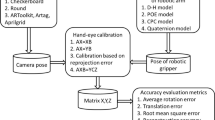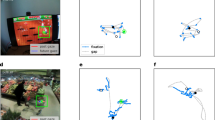Abstract
This paper presents a two-stage smooth-optimal trajectory tracking strategy. Different from existing methods, the optimal trajectory tracked point can be directly determined in an uncalibrated fish-eye image. In the first stage, an adaptive trajectory tracking controller is employed to drive the tracking error and the estimated error to an arbitrarily small neighborhood of zero. Afterwards, an online smooth-optimal trajectory tracking planner is proposed, which determines the tracked point that can be used to realize smooth motion control of the mobile robot. The tracked point in the uncalibrated image can be determined by minimizing a utility function that consists of both the velocity change and the sum of cross-track errors. The performance of our planner is compared with other tracked point determining methods in experiments by tracking a circular trajectory and an irregular trajectory. Experimental results show that our method has a good performance in both tracking accuracy and motion smoothness.
Similar content being viewed by others
References
K. C. Koh, H. S. Cho. A smooth path tracking algorithm for wheeled mobile robots with dynamic constraints. Journal of Intelligent and Robotic Systems, vol.24, no.4, pp. 367–385, 1999. DOI: 10.1023/A:1008045202113.
T. M. Howard, R. A. Knepper, A. Kelly. Constrained optimization path following of wheeled robots in natural terrain. Experimental Robotics, O. Khatib, V. Kumar, D. Rus, Eds., Berlin, Germany: Springer, pp. 343–352, 2008. DOI: 10.1007/978-3-540-77457-032.
T. K. Lee, S. H. Baek, Y. H. Choi, S. Y. Oh. Smooth coverage path planning and control of mobile robots based on high-resolution grid map representation. Robotics and Autonomous Systems, vol.59, no.10, pp.801–812, 2011. DOI: 10.1016/j.robot.2011.06.002.
J. Chen, W. E. Dixon, M. Dawson, M. Mclntyre. Homo graphy-based visual servo tracking control of a wheeled mobile robot. IEEE Transactions on Robotics, vol.22, no.2, pp.406–415, 2006. DOI: 10.1109/TRO.2006.862476.
B. Q. Li, Y. C. Fang, X. B. Zhang. Visual servo regulation of wheeled mobile robots with an uncalibrated onboard camera. IEEE/ASME Transactions on Mechatronics, vol.21, no.5, pp.2330–2342, 2016. DOI: 10.1109/TMECH. 2015.2504098.
T. C. Lee, C. Y. Tsai, K. T. Song. Fast parking control of mobile robots: A motion planning approach with experimental validation. IEEE Transactions on Control Systems Technology, vol.12, no. 5, pp. 661–676, 2004. DOI: 10.1109/TCST.2004.826964.
J. B. Coulaud, G. Campion, G. Bastin, M. de Wan. Stability analysis of a vision-based control design for an autonomous mobile robot. IEEE Transactions on Robotics, vol.22, no.5, pp. 1062–1069, 2006. DOI: 10.1109/TRO. 2006.878934.
J. Chen, B. X. Jia, K. X. Zhang. Trifocal tensor-based adaptive visual trajectory tracking control of mobile robots. IEEE Transactions on Cybernetics, vol.47, no. 11, pp. 3784–3798, 2017. DOI: 10.1109/TCYB.2016.2582210.
R. K. Mandava, P. R. Vundavilli. Near optimal PID controllers for the biped robot while walking on uneven terrains. International Journal of Automation and Computing, vol.15, no.6, pp.689–706, 2018. DOI: 10.1007/s11633-018-1121-3.
T. Fukao, H. Nakagawa, N. Adachi. Adaptive tracking control of a nonholonomic mobile robot. IEEE Transactions on Robotics and Automation, vol.16, no. 5, pp. 609–615, 2000. DOI: 10.1109/70.880812.
W. E. Dixon, D. M. Dawson, E. Zergeroglu, A. Behal. Adaptive tracking control of a wheeled mobile robot via an uncalibrated camera system. IEEE Transactions on Systems, Man, and Cybernetics, Part B (Cybernetics), vol. 31, no. 3, pp. 341–352, 2001. DOI: 10.1109/3477.931519.
X. W. Liang, H. S. Wang, W. D. Chen, D. J. Guo, T. Liu. Adaptive image-based trajectory tracking control of wheeled mobile robots with an uncalibrated fixed camera. IEEE Transactions on Control Systems Technology, vol. 23, no.6, pp. 2266–2282, 2015. DOI: 10.1109/TCST.2015.2411627.
X. B. Zhang, Y. C. Fang, B. Q. Li, J. Wang. Visual servoing of nonholonomic mobile robots with uncalibrated camera-to-robot parameters. IEEE Transactions on Industrial Electronic, vol.64, no. 1, pp.390–400, 2017. DOI: 10.1109/TIE.2016.2598526.
H. M. Becerra, C. Sagues. A sliding mode control law for epipolar visual servoing of differential-drive robots. In Proceedings of IEEE/RSJ International Conference on Intelligent Robots and Systems, IEEE, Nice, France, pp. 3058–3063, 2008. DOI: 10.1109/IROS.2008.4650754.
H. M. Becerra, G. Lopez-Nicolas, G. Sagues. A slidingmode-control law for mobile robots based on epipolar visual servoing from three views. IEEE Transactions on Robotics, vol.27, no. 1, pp. 175–183, 2011. DOI: 10.1109/TRO.2010.2091750.
K. Wang, Y. H. Liu, L. Y. Li. Visual servoing trajectory tracking of nonholonomic mobile robots without direct position measurement. IEEE Transactions on Robotics, vol.30, no.4, pp. 1026–1035, 2014. DOI: 10.1109/TRO.2014.2317891.
L. Y. Li, Y. H. Liu, T. J. Jiao, K. Wang, M. Fang. Adaptive trajectory tracking of nonholonomic mobile robots using vision-based position and velocity estimation. IEEE Transactions on Cybernetics, vol.48, no.2, pp.571–582, 2018. DOI: 10.1109/TCYB.2016.2646719.
H. S. Wang, Y. H. Liu, W. D. Chen. Uncalibrated visual tracking control without visual velocity. IEEE Transactions on Control Systems technology, vol.18, no.6, pp. 1359–1370, 2010. DOI: 10.1109/TCST.2010.2041457.
A. Saradagi, V. Muralidharan, V. Krishnan, S. Menta, A. D. Mahindrakar. Formation control and trajectory tracking of nonholonomic mobile robots. IEEE Transactions on Control Systems Technology, vol.26, no.6, pp.2250–2258, 2018. DOI: 10.1109/TCST.2017.2749563.
B. S. Park, S. J. Yoo, J. B. Park, Y. H. Choi. A simple adaptive control approach for trajectory tracking of electrically driven nonholonomic mobile robots. IEEE Transactions on Control Systems Technology, vol.18, no.5, pp. 1199–1206, 2010. DOI: 10.1109/TCST.2009.2034639.
J. M. Yang, J. H. Kim. Sliding mode control for trajectory tracking of nonholonomic wheeled mobile robots. IEEE Transactions on Robotics and Automation, vol.15, no.3, pp. 578–587, 1999. DOI: 10.1109/70.768190.
B. D. Ning, Q. L. Han. Prescribed finite-time consensus tracking for multiagent systems with nonholonomic chained-form dynamics. IEEE Transactions on Automatic Control, vol.64, no.4, pp. 1686–1693, 2019. DOI: 10.1109/TAC.2018.2852605.
W. M. Bessa. Some remarks on the boundedness and convergence properties of smooth sliding mode controllers. International Journal of Automation and Computing, vol.6, no.2, pp. 154–158, 2009. DOI: 10.1007/s11633-009-0154-z.
D. Verscheure, B. Demeulenaere, J. Swevers, J. de Schutter, M. Diehl. Time-optimal path tracking for robots: A convex optimization approach. IEEE Transactions on Automatic Control, vol.54, no.10, pp.2318–2327, 2009. DOI: 10.1109/TAC.2009.2028959.
F. Boe, B. Hannaford. Online improvement of speed and tracking performance on repetitive paths. IEEE Transactions on Control Systems Technology, vol.6, no.3, pp. 350–358, 1998. DOI: 10.1109/87.668036.
W. C. Sun, S. Y. Tang, H. J. Cao, J. Zhao. Two time-scale tracking control of nonholonomic wheeled mobile robots. IEEE Transactions on Control Systems Technology, vol.24, no.6, pp.2059–2069, 2016. DOI: 10.1109/TCST.2016.2519282.
B. Tovar, R. Murrieta-Cid, S. M. LaValle. Distance-optimal navigation in an unknown environment without sensing distances. IEEE Transactions on Robotics, vol. 23, no.3, pp. 506–518, 2007. DOI: 10.1109/TRO.2007.898962.
M. Park, S. Lee, W. Han. Development of steering control system for autonomous vehicle using geometry-based path tracking algorithm. ETRI Journal, vol.37, no.3, pp.617–625, 2015. DOI: 10.4218/etrij.15.0114.0123.
H. Yang, V. Cocquempot, B. Jiang. Optimal fault-tolerant path-tracking control for 4WS4WD electric vehicles. IEEE Transactions on Intelligent Transportation Systems, vol.11, no. 1, pp. 237–243, 2010. DOI: 10.1109/TITS.2009.2033374.
T. Ardeshiri, M. Norrlof, J. Lofberg, A. Hansson. Convex optimization approach for time-optimal path tracking of robots with speed dependent constraints. IFAC Proceedings Volumes, vol.44, no.1, pp. 14648–14653, 2011. DOI: 10.3182/20110828-6-IT-1002.01136.
J. Kieffer, A. J. Cahill, M. R. James. Robust and accurate time-optimal path-tracking control for robot manipulators. IEEE Transactions on Robotics and Automation, vol.13, no.6, pp.880–890, 1997. DOI: 10.1109/70.650167.
Y. Z. Huang, X. B. Zhang, Y. C. Fang. Vision-based minimum-time planning of mobile robots with kinematic and visibility constraints. IFAC Proceedings Volumes, vol. 47, no.3, pp. 11878–11883, 2014. DOI: 10.3182/20140824-6-ZA-1003.01791.
G. Chesi, Y. S. Hung. Global path-planning for constrained and optimal visual servoing. IEEE Transactions on Robotics, vol.23, no.5, pp. 1050–1060, 2007. DOI: 10.1109/TRO.2007.903817.
A. H. A. Hafez, A. K. Nelakanti, C. V. Jawahar. Path planning for visual servoing and navigation using convex optimization. International Journal of Robotics and Automation, 2015. DOI: 10.2316/Journal.206.2015.3.206-4271.
R. Saravanan, S. Ramabalan, C. Balamurugan, A. Subash. Evolutionary trajectory planning for an industrial robot. International Journal of Automation and Computing, vol.7, no.2, pp. 190–198, 2010. DOI: 10.1007/s11633-010-0190-8.
F. A. Cheein. Intelligent sampling technique for path tracking controllers. IEEE Transactions on Control Systems Technology, vol.24, no.2, pp.747–755, 2016. DOI: 10.1109/TCST.2015.2450180.
K. Yang, S. Sukkarieh. An analytical continuous-curvature path-smoothing algorithm. IEEE Transactions on Robotics, vol.26, no. 3, pp. 561–568, 2010. DOI: 10.1109/TRO.2010.2042990.
D. F. Dementhon, L. S. Davis. Model-based object pose in 25 lines of code. International Journal of Computer Vision, vol.15, no. 1-2, pp. 123–141, 1995. DOI: 10.1007/BF01450852.
Z. B. Kang, W. Zou, H. X. Ma, Z. Zhu. Adaptive trajectory tracking of wheeled mobile robots based on a fish-eye camera. International Journal of Control, Automation and Systems, vol.17, no.9, pp.2297–2309, 2019. DOI: 10.1007/s12555-019-0006-8.
O. Amidi. Integrated Mobile Robot Control, CMU-RI-TR-90-17, Carnegie Mellon University, Pittsburgh, USA, 1990.
S. Thrun, M. Montemerlo, H. Dahlkamp, D. Stavens, A. Aron, J. Diebel, P. Fong, J. Gale, M. Halpenny, G. Hoffmann, K. Lau, C. Oakley, M. Palatucci, V. Pratt, P. Stang, S. Strohband, C. Dupont, L. E. Jendrossek, C. Koelen, C. Markey, C. Rummel, J. van Niekerk, E. Jensen, P. Alessandrini, G. Bradski, B. Davies, S. Ettinger, A. Kaehler, A. Nefian, P. Mahoney. Stanley: The robot that won the DARPA grand challenge. Journal of Field Robotics, vol.23, no.9, pp.661–692, 2006. DOI: 10.1002/rob. 20147.
Acknowledgements
This work was supported by National Key Research and Development Program (No. 2018YFB1306303) and National Natural Science Foundation of China (No. 61773374).
Author information
Authors and Affiliations
Corresponding author
Additional information
Recommended by Associate Editor Qing-Long Han
Zhao-Bing Kang received the B. Eng. degree in mechanical engineering and automation from Dezhou University, China in 2008, the M. Eng. degree in mechanical and electronic engineering from Harbin Institute of Technology, China in 2016. Currently, he is a Ph.D. degree candidate in Institute of Automation at Chinese Academy of Science (CASIA), China. He is also with University of Chinese Academy of Science, China.
His research interests include visual servoing and robot location and navigation.
Wei Zou received the B.Eng. degree in control science and engineering from Baotou University of Iron and Steel Technology, China in 1997, the M.Eng. degree in control science and engineering from Shandong University of Technology, China in 2000, and the Ph.D. degree in control science and engineering from Institute of Automation, Chinese Academy of Science (CASIA), China in 2003. Currently, he is a professor at the Research Center of Precision Sensing and Control, CASIA.
His research interests include intelligent robotics, visual servoing, and robot localization and navigation.
Zheng Zhu received the B.Sc. degree from Zhengzhou University, China in 2014. He is currently a Ph.D. degree candidate in IACAS, China. He is also with University of Chinese Academy of Sciences, China.
His research interests include computer vision, deep learning and robotics.
Hong-Xuan Ma received the B.Sc. degree from Central South University, China in 2016. He is currently a Ph.D. degree candidate in CASIA, China. He is also with University of Chinese Academy of Sciences, China.
His research interests include computer vision and robotics.
Rights and permissions
About this article
Cite this article
Kang, ZB., Zou, W., Zhu, Z. et al. Smooth-optimal Adaptive Trajectory Tracking Using an Uncalibrated Fish-eye Camera. Int. J. Autom. Comput. 17, 267–278 (2020). https://doi.org/10.1007/s11633-019-1209-4
Received:
Accepted:
Published:
Issue Date:
DOI: https://doi.org/10.1007/s11633-019-1209-4




